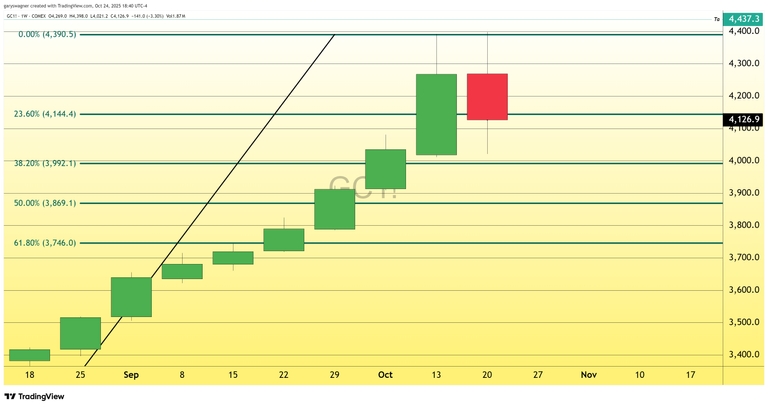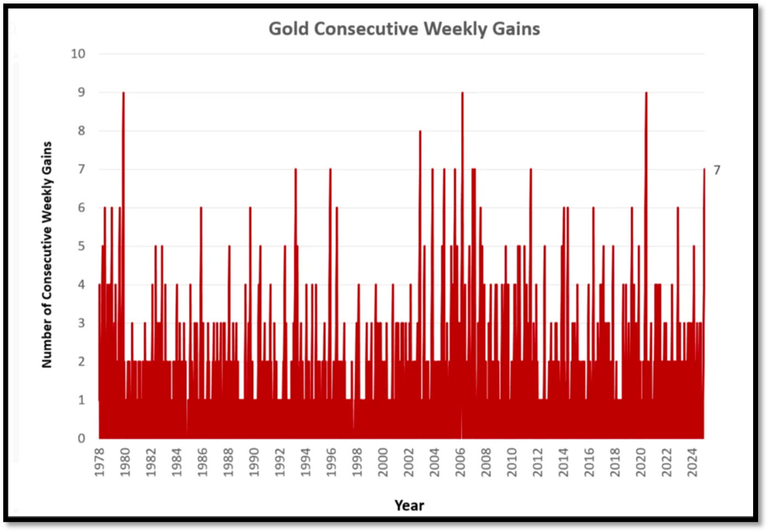(Kitco Commentary) - The precious metals market has delivered extraordinary returns over the past two years, with both gold and silver climbing 149% since October 2023. Remarkably, approximately half of these substantial gains have materialized in just the last two months, underscoring the intensity of the recent rally. However, the meteoric rise encountered a natural pause at the start of this week as both metals experienced a healthy technical correction.
The pullback brought silver to a 38% Fibonacci retracement level, with gold approaching a similar threshold. These retracement calculations are based on the price action spanning sixty-one trading days, from Wednesday, August 20th through Monday, October 20th. During this period, both metals accomplished something exceptionally rare in commodity markets: a nine-week winning streak.

The significance of this achievement becomes clear when examined through a historical lens. Gold has recorded nine consecutive weekly gains only three times previously since 1978, making this most recent occurrence just the fourth instance in nearly five decades. Silver's accomplishment is equally uncommon. More striking still, gold has never extended a winning streak to ten weeks without registering at least one weekly decline throughout its modern trading history.

Historical data reveals an intriguing pattern regarding gold's performance following extended rallies. According to research compiled by 25-year financial analyst Eric L., returns following any winning streak of seven or more consecutive weeks tend to be negative, albeit only modestly so. His analysis of forward returns following these rare instances presents a sobering picture for near-term performance expectations.
The median forward returns following the conclusion of such extended rallies show consistent weakness across multiple timeframes. One week after these streaks end, gold has historically declined by 3.3%. The weakness persists through the two-week mark at negative 3.2%, deepening to negative 4.2% after four weeks. The trend continues with median declines of 6.0% at the ten-week mark and 6.1% at twenty weeks. Only at the 52-week horizon do returns flatten to zero percent.
Perhaps most notable is the probability of decline following these extended rallies. The likelihood of negative returns has ranged from 82.3% to 100% across various timeframes after the streaks concluded, reflecting what the analyst characterizes as "predominantly bearish sentiment." This historical pattern suggests a high probability of underperformance within the first twenty weeks following such rallies, though longer-term prospects remain less clear.
Meanwhile, macroeconomic developments continue to shape the broader investment landscape. The highly anticipated September Consumer Price Index report was released today, showing annual inflation of 3.0% for the twelve-month period—slightly below the consensus expectation of 3.1%. While the month-over-month reading still represented a 0.3% increase, the cooler-than-expected annual figure provided modest relief to markets concerned about persistent price pressures.
Despite the marginal surprise in the inflation data, expectations for Federal Reserve policy remained largely unchanged. According to the CME Group's FedWatch tool, which aggregates market-based probabilities for future rate decisions, the likelihood of a quarter-point rate cut at next week's meeting declined only minimally—from 98.3% to 96.7%—following the CPI release. This stability suggests that the inflation report contained no major surprises sufficient to alter the prevailing policy outlook.
Technical Versus Fundamental Drivers
Analysis of this week's decline in precious metals suggests that the correction stemmed primarily from technical factors and profit-taking rather than any fundamental shift in market sentiment or economic conditions. After such an extraordinary rally, a period of consolidation appears not only natural but healthy for the sustainability of the broader uptrend.
From a technical perspective, both gold and silver appear poised to resume their advance toward higher price levels once a stable base is established—a process that may have already begun. This outlook assumes no major fundamental shifts in monetary policy or unexpected macroeconomic developments that could alter the supportive backdrop for precious metals.
The combination of accommodative monetary policy expectations, persistent inflation concerns, and strong technical momentum suggests that the recent pullback may represent a buying opportunity rather than the beginning of a more sustained reversal. However, investors would be wise to consider the historical patterns identified in extended winning streaks, which counsel caution regarding near-term performance expectations even as longer-term fundamentals remain constructive for the precious metals complex.
For those that would like more information about our services click here
Wishing you as always good trading,

